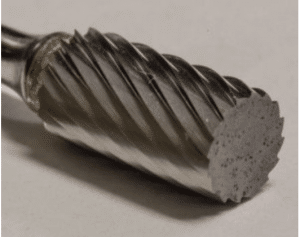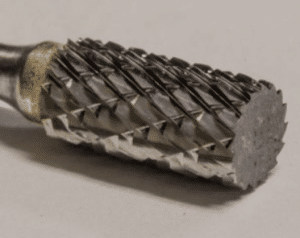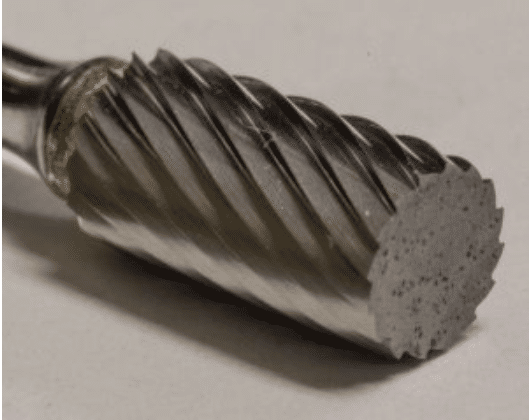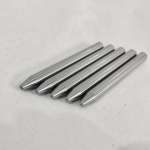Description
We specialize in tungsten carbide burrs, which is also known as die grinder bits. despite those burrs made by other materials like alloy steel and high-speed steel.
1. The Advantages of Tungsten Carbide die grinder bits
- Long life
- Use for long production runs
- High stock removal
- Ideal for using on many hard and tough materials
- Ideal for Deburring, finishing, carving, shaping and smoothing welds, molds, dies and forgings
2.Material of workpieces
Thanks to the excellent hardness of the tungsten carbide, they are very suited to be used on most hard materials, such as steel, non-ferrous metal alloy, cast iron, and reinforced plastics. With tungsten carbide, you can run your burr bits in a hotter environment, in which HSS burrs will start to melt.
- Steel, Carbon Steel & Stainless Steel
- Cast Iron
- Aluminum
- Titanium
- Cobalt
- Nickel
- Gold, Platinum & Silver
- Ceramics
- Fiberglass
- Plastic, Carbon Fiber Reinforced Plastic (CRP), Glass Fibre Reinforced Plastic (GRP)
- Brass, Copper & Bronze
- Zinc
- Wood
3.Specific application
Carbide burrs are found in tools such asdie grinders, pneumatic rotary tools, high-speed engravers, micro Motors, pendant Drills, and flexible shafts, and hobby rotary tools. They are ideal for metalworking, tool making, wood carving, jewelry making, welding, chamfering, casting, deburring, grinding, cylinder head porting, and sculpting in the aerospace, automotive, dentistry, stone, and metalsmith industries.
4. Two types of a carbide die grinder bit’s cut

Single Cut carbide burrs have a right-handed (Up cut) spiral flute. These tend to be used with stainless steel, hardened steel, copper, cast iron, and ferrous metals and will remove material quickly with a smooth finish.
- Heavy removal of material
- Milling
- Deburring
- Cleaning
- Creates long chips
D ouble Cut carbide burrs tend to be used on ferrous and nonferrous metals, aluminum, soft steel and also for all non-metal materials such as plastics and wood, in medium-light stock removal, deburring, finishing, and cleaning. They have more cutting edges and will remove material faster. 2 flutes cut will leave a smoother finish than single cut when producing smaller chips as they cut away the material. A double cut carbide burr will see you through the following applications,
ouble Cut carbide burrs tend to be used on ferrous and nonferrous metals, aluminum, soft steel and also for all non-metal materials such as plastics and wood, in medium-light stock removal, deburring, finishing, and cleaning. They have more cutting edges and will remove material faster. 2 flutes cut will leave a smoother finish than single cut when producing smaller chips as they cut away the material. A double cut carbide burr will see you through the following applications,
- Medium-light removal of material
- Deburring
- Fine finishing
- Cleaning
- Smooth finish
- Creates small chips
5.The Common shank sizes of the carbide grinder bit:
The shank is the base of a burr that fits into your rotary tool, die grinder, micro motor etc; In general rotary burrs comprise the following shank sizes:
Metric | Inch |
1.6mm | 1/16″ |
2.35mm | 3/32″ |
3mm | 1/8″ |
6mm | 1/4″ |
6. Suggested RPM speed
On the general principle, the speed at which you use the carbide burr will depend on the material you are processing, as long as it’s no less than 6000 and no more than 35,000. It’s a concern that while the speed is too slow, your burrs may chip easily. The correct way to drive your burr is making a slow start-up, then gradually reaching up into the burr’s proper speed which will effectively prevent the clogging of flutes and burr shaft’s breaking. Appropriate working velocity for each type will be recommended by us.
Diameter of Burr | RPM |
1.6mm or 1/16″ | 25,000 – 35,000 |
2.35mm or 3/32″ | 17,000 – 26,000 |
3mm or 1/8″ | 17,000 – 26,000 |
6mm or 1/4″ | 11,000 – 16,500 |
12mm or 1/2″ | 8,000 – 12,000 |
16mm or 5/8″ | 7,650 – 11,500 |
7. The Shapes of carbide burrs
Making good full use of carbide rotary burrs incorrect shapes will carve out profiles or cuts that you exactly need.
Carbide Ball Burrs–D type
Ball or spherically shaped carbide burr is to create concave cuts or a hollowed-out area. Small carbide ball burrs from as tiny as 0.5mm in diameter are ideal for intricate carving projects. Many wood carvers, stone carvers, and metal engravers use these carbides carving burrs in a hobby drill, micro motor or a high-speed handpiece. As we mentioned before, make sure to use a handpiece that runs true i.e with no wobble.
Carbide Tree Burrs
Use for rounding off edges and making concave cuts. Use the pointed end for cutting in hard to reach areas and acute-angled contours.
Carbide Inverted Cone Burrs
Use inverted cone-shaped tungsten carbide burrs for making v-cuts and rear side chamfering.
Carbide Pointed Cone & Carbide Round Nose or Ball Nose Burrs
Good for rounded edges and surface finishing in difficult to reach areas or tight and narrow angles and contours. The round nose or ball nose cone are often referred to as a taper shape.
Cylinder Burrs. Round Nose/Ball nose/End Cut
Choose from an end cut cylinder (with a cutting edge on the end) for contour finishing. Cylinder without end cut (flat on the end and no cutting edge) for contour finishing and right-angled corners or around nose or ball nose shape which is a cylinder-shaped carbide burr but with a rounded head.
Oval Burrs
Flame Burrs
Oblate Spheroid
A wheel-shaped burr with a smooth top and fluted sides. Great for channel work and shaping.
Countersink Burrs
Choose from 60 degree or 90-degree angle countersink burs, sometimes referred to carbide cone burrs. These are ideal for beveling, counterboring, chamfering and for getting into acutely angled areas of your work.
8.Showcase of our burrs/grinder bits
We supply a good selection of premium quality carbide die grinder bits available for you to purchase from our inventory. For larger quantities or unusual shapes please feel free to contact us.
…



Reviews
There are no reviews yet.